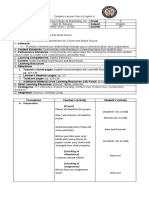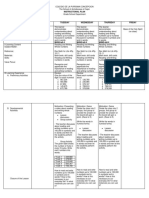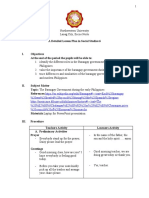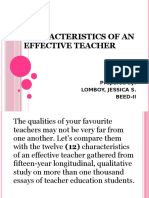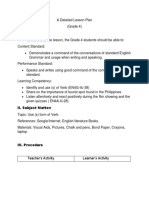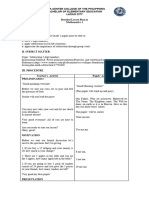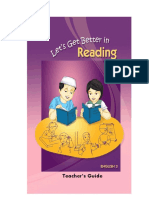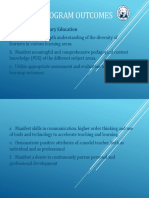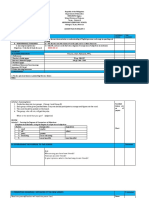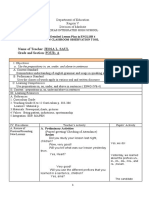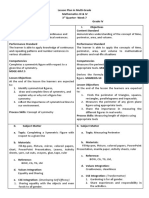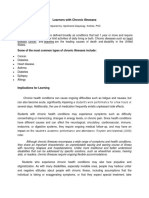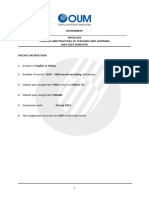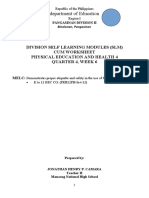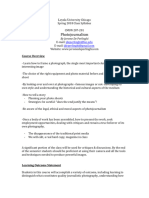PROF ED 7 - The Teacher and The School Curriculum: Talisay City College
Uploaded by
elisha lasolaPROF ED 7 - The Teacher and The School Curriculum: Talisay City College
Uploaded by
elisha lasolaRepublic of the Philippines
Province of Cebu
City of Talisay
TALISAY CITY COLLEGE
Poblacion, Talisay City, Cebu
nd
2 Semester, Academic Year 2020-2021
PROF ED 7 – The Teacher and the School Curriculum
Course Facilitator DELETAH DG. POLINAR Department Teacher Education
Teacher Contact No.
Program & Year BEED and BSED II Credit Units 3.0
This course includes the fundamental concepts and principles in curriculum and
curriculum development as a foundation to engage prospective teachers as
curricularists. The more active role of the teacher in planning, implementing and
Course Description
evaluating school-curriculum as well as in managing school curriculum change vis-à-
vis various context of teaching-learning and curricular reforms shall be given
emphasis
Develop a responsive and relevant Vision, Mission, Goals and Objectives of their
Culminating Outcome
envisioned school.
Identify the fundamentals in designing a curriculum using curriculum approaches as its
Midterm Unit Outcome foreground of approaches and analyze what process is to be undertaken if a
curriculum is changed or modified.
Student’s Name Curricular Yr.& Sec.
Contact No. Time Allotment
Residence Inclusive Date/s
Course Implementing the Curriculum Daily in the
Material 4 Classrooms
CONTENT LEARNING OBJECTIVES
The Role of Technology in Delivering the At the end of this course material, you will…
Curriculum Identify the words that are related to curriculum
Stakeholders in Curriculum Implementation technology, stakeholders and evaluation
What, Why and How to Evaluate a Curriculum Reflect on the roles of the stakeholders making the
student as a school manager
Develop a curriculum evaluation design on the modality
we are currently experiencing
ENGAGE
We have given examples of curriculum design and the corresponding approaches. Again, the choice of the design
is influenced by philosophical and psychological beliefs of the designer. Please fill – in the blanks that are provided in
this area:
The _________________ design corresponds mostly to the textbook because textbooks are usually written based
on the specific subject or course. It has various variations which are focused on the _________________ which is known
as the oldest and so far the most familiar design. The _________________ is centered on a cluster of academic
discussions which is often used in college. There are two more designs in this design and these are the
_________________ and _________________.
The Learner-centered design is regarded by the _________________ educational philosophers as a strong design in
the elementary level making the _________________ as the center of the educative process. There are three designs
that are very common and these are: the _________________, _________________ and _________________ with
popular proponents such as _________________, _________________ and _________________, respectively.
The third and the last design is problem – centered design which is drawn on _________________ problems and
the needs and _________________ of the learner. The connection of the subject matter to real situations increases the
relevance of the _________________ design while the _________________ design centers on general education and
problems that are based on the common human activities.
EXPLORE
Role of Technology in Delivering the Curriculum
by Bilbao, P., Dayagbil, F., Corpuz, B.
Source: p.86-89 Curriculum Development
First, What is Technology? Technology comes from the Greek word “techne” which means craft or art. It is a
planned systematic method of working to achieve planned outcomes. It refers to any valid and reliable process or
procedure that is derived from basic to scientific. Also, it refers to all the way of people use their inventions and
THIS MATERIAL IS FOR EDUCATIONAL USE ONLY AND NOT FOR SALE. Page 1 of 9
discoveries to satisfy their needs and desires. How can Technology be used to Improve Learning? According to Joy
Waddell (2015) there are ways that technology could be better leveraged to improve learning if teachers will identify
learning objectives and differentiate instruction based on the needs of their learners. Also, when teachers attempt to
present instruction using technology, they should do so using a change that is relevant to the objectives, the learning
style, mode and the technology selected. Moreover, technology is central to many sectors of society and its
integration into the education process has great promise for student learning with an expectation of increased
efficiency and effectiveness on both the part of teachers and students. After learning fundamental concepts about the
curriculum – its nature and development, comes the practical phase of curriculum implementation. Appropriately, the
significance of technology in curriculum development. The role of technology in the curriculum springs from the very
vision of the e-Philippine plan (e for electronic). Thus it is stated: “an electronically enabled society where all citizens live
in an environment that provides quality education, efficient government services, greater sources of livelihood and
ultimately a better way of life through enhanced access to appropriate technologies. The features of E-learning are: it is
dynamic, it operates in real time, it is cooperative, it is individual, and it is comprehensive. The features point to the need
for an e-curriculum or a curriculum which delivers learning consonant with the information technology and
communications technology (ICT) revolution. This framework presupposes that curriculum delivery adopts ICT as
important tool in education while users implement teaching-learning strategies that conform to the digital
environment.
Let us now go to the discussion of instructional medial which is also referred to as media technology or learning
technology. Technology plays a crucial role in delivering instruction to learners. Technology offers various tools of
learning and these ranges from non-projected to projected media depending on what he sees fit with the intended
instructional setting. When we say instructional setting we mean the availability of equipment which the school
administration can afford, the location of your school (whether there is or there is no power supply) and more importantly,
the teacher’s knowledge and skill in using the equipment.
Let us not discuss thoroughly, just a presented classification is shown, the entire type of media, non-projected
media or projected media, as you have learned this when you had your Prof Ed 5. Just in case it was not discussed by
your teacher, please refer it with your teacher during your virtual classes. Types of Media Technology
Non-projected Media Projected Media
Real objects Models Overhead projector Opaque Projector
Printed Materials Field Trips Slide Projector Video, VCD, DVD
(books, worksheets) Kits Filmstrips Betamax (before) let me include
Visuals (drawings, Visual boards such as Computer/laptop Multi- this one because some schools still
graphs, photographs, (chalkboard, whiteboard, media presentations have this as a donation from
charts, posters) flannel board ) LCD Projectors private entities
Audio Materials
Factors in Technology Selection
In deciding on which technology to use from a wide range of media available, the factors on which to base
selection are: (Note: the questions asked in each factor will guide you answering the practicality, appropriateness,
suitability and objective matching)
1. Practicality. Is the equipment (hardware) or already prepared lesson material (software) available? If not, what
would be the cost in acquiring the equipment or producing the lesson in audial or visual form? We all believe that
acquiring good or quality equipment will entail a big amount for the school administrator to spend. Therefore, let check if it
is very practical for the teachers to use it in their teaching-learning task.
2. Appropriateness in relation to the learners. Is the medium suitable to the learners’ ability to comprehend? LCD
Projector with a pair the teacher’s laptop is very ideal. But let us consider who the type of learners do the teachers have.
Do they not have visual or hearing impairment? If the students are visually impaired how would they appreciate the lesson
if they see nothing? And for those who have hearing impairment, what will they hear unless otherwise there are subtitles or
the animation have caricatures of text that becomes appropriate. Will the medium be a source of plain amusement or
entertainment, but not learning? There are teachers who use film showing or movie stories in their lessons with simple
instruction of “please watch this movie”. This gives us an impression that teachers did not prepare guide questions to the
students while watching the film/movie that will lead them to a more of an entertainment than a supplementary lesson for
their existing lesson. What am I trying to drive at? Teachers should prepare a lesson guide prior to the viewing of the
material so that students will be more cognizant on portions that will lead them to answer the activity. Thus, learning will
take place.
3. Activity/Suitability. Will the chosen media fit the set instructional event, resulting in either information,
motivation, or psychomotor display? Let us go back to the table presented above that classified non-projected and
projected media. Let us use Field Trips as an example. If you think that it is not dangerous, not costly, and not cumbersome
to use this medium why not use it when you will find it very suitable for your activity. Another example is the models
(realia). When the teacher’s discussion is the Earth’s rotation and revolution it is very difficult to use a printed material or a
graph nor a chart for this activity. Therefore, as a teacher you should use models (made of styrophor if you do not have it in
the bukid paper mache) where you can rotate and revolve the material for the students to see the difference between
rotation and revolution.
4. Objective – Matching. Over-all, does the medium help in achieving the learning objectives? Recall the lessons you
THIS MATERIAL IS FOR EDUCATIONAL USE ONLY AND NOT FOR SALE. Page 2 of 9
learned from your teachers on the formulation of objectives. If the teacher’s objective in the lesson Philippine Geography is
the students will match the product, industry, tourist spot of each region therefore there is a specific instructional
material we should use. Let me therefore ask you, what material should we use? Can we use filmstrips? How about VCD or
DVD? Are they possible? No, it is impossible because you could not edit the material prepared by the maker. But using a
flannel board with pictures, drawings, posters, postcards is more appropriate because you are able to let the students
match the region with the specified elements.
The Role of Technology in Curriculum Delivery
Technological changes in education will make its impact on the delivery of more effective, efficient and humanizing
teaching-and-learning. There are 3 trends that could carry on to the nature of education in the future.
The 1st trend is the paradigm (model/pattern) shift from teacher-centered to student-centered approach to learning.
John Dewey (a progressivist) insisted that the old model of schooling – students sitting in rows, memorizing and reciting –
was antiquated. Students should be active, not passive. They required compelling and relevant projects, not lectures.
Students should become problem solvers. Jerome Bruner (a constructivist) proposes that learners construct their own
knowledge and do this by organizing and categorizing information using a coding system. The concept of discovery learning
implies that students construct their own knowledge.
The 2nd trend is the broadening realization that education is not simply a delivery of facts and information but an
educative process of cultivating the cognitive, affective, psychomotor and much more the contemplative intelligence
of the learners of a new age. Learning is not only an improved knowledge on facts and information but a process of
modifying adjustment in one’s perceptual thinking (cognitive), reflective form of attitude (affective), and readiness in skills
(psychomotor) that can help them become a more effective, efficient and competent individual members of our ever
changing society. Again, Dewey puts education as the light of the rapid social and economic changes in the world.
Education should ensure an adequate preparation for immediate life. Education should encourage pupil to learn making
the school as an essential social and psychological institution.
The 3rd trend is the increase in the use of new information and communication technology (ICT). Ratheeswari (2018)
construed ICT as a dynamic change in society. It influences all aspects of life and these influences are felt more and more at
schools. Because ICT provides both students and teachers with more opportunities in adapting learning and teaching to
individual’s needs forcing schools to respond to technical innovation.
The primary roles of educational technology in delivering the school curriculum’s instructional program are:
1) Upgrading the quality of teaching – and – learning in schools
2) Increasing the capability of the teacher to effectively inculcate learning and for students to gain mastery of lessons
and courses.
3) Broadening the delivery of education outside schools through non-traditional approaches to formal and informal
learning.
4) Revolutionizing the use of technology to boost educational paradigm shifts that give importance to student
centeredness and holistic learning.
Stakeholders in Curriculum Implementation
by Bilbao, P., Dayagbil, F., Corpuz, B.
Source: p.92-106 Curriculum Development
What is a stakeholder? Stakeholder can be defined in many ways depending how you will use it. As far education is
concerned, edglosarry defined it as to anyone who has invested in the welfare and success of a school and its students,
including administrators, teachers, staff members , parents, families, community members, local business leaders and
elected officials of a state or government. Stakeholders can also be called as Collaborator, Colleague, Partner,
Shareholder, Participant or Associate. With that, you can already have an idea who are those people whom you can call
as partners in the school where you will be connected with. These are:
1) LEARNERS the core of the curriculum
the recipients of the curriculum
the dynamic participants in the planning, designing, implementing and evaluating
involved in the curriculum and their involvement is based on their maturity
make or break curriculum implementation by their active or non-involvement
put action to the curriculum together with the teachers
they make curriculum alive
Explanation: If not for the learners the curriculum will not exist. That is why in the 1 st function they are the core of the
curriculum is said.
2) TEACHERS are the curricularists
they plan, design, teach, implement and evaluate the curriculum making
the most important person in curriculum implementation
are stakeholders that need to continue with their professional development as it is contributory to their
participation in the curriculum development
they possess the full knowledge of the program, philosophy, content and components
THIS MATERIAL IS FOR EDUCATIONAL USE ONLY AND NOT FOR SALE. Page 3 of 9
they manage the ways of teaching and they are also they are module writers
design, enriches and modifies the curriculum to suit the learner's characteristics
they should be part of the school's textbook committee
teachers are like technicians that when the curriculum is implemented they see to it that it is workable
or does not lead to failure
they reflect on the curriculum as they put their hearts in what they do
they are mindful that the center of everything they do, is the learner
Explanation: Reading the functions of teachers, you will notice how they work side by side with any of these other
stakeholders. In fact, others would claim that they are the key players in the implementation of the curriculum.
3) SCHOOL LEADERS are the curriculum managers
they understand fully the need for change in the implementation process
they should be ready to assist the teachers and students in the implementation
must open the communication lines in both or all ends that will lead to teamwork
they are the frontliners of the school
they should be committed to change and should employ strategies to meet the needs of the teachers,
learners, facilities and other resources
Explanation: School administrators have functions separate and distinct from the teachers. I can clearly remember
when a Music Teacher wanted to equip our school’s Music Room. He requested for an amount from the Management
and when it was granted the purchase of musical instruments was managed by him and me as the overseer of the funds
granted by our school administrators.
4) PARENTS are significant school partners
they equally have a role to play in the curriculum implementation
they raise their concerns regarding students' books, resources, activities, grading system and
sometimes school management
they engage themselves in the school program or activities
they volunteer to help in various activities that are within their lines of their professions
they may not be directly involved, but are formidable partners in the success of curriculum endeavor
How do parents help shape the curriculum in schools?
1) The school is composed of parents who are positively involved in school activities have better achievement than
schools with uninvolved parents. Disciplinary problems are minimal and students are highly motivated when parents take
interest in their child's learning. They become closer to the school.
2) The home is the extended school environment. In lifelong learning, the achieved learning in schools is transferred at
home. Thus, the home becomes the laboratory of learning. Thus, parents see to it that what children learn in school is
practiced at home. They follow up lessons. They make available materials for learning and they give permission for the
participation of their children.
3) In most schools, parent associations are organized. This is being encouraged in school-based management. The
organization also includes teachers to expand the school learning community. Many school projects and activities are
supported by this organization. This is considered as the best practice in most performing schools.
Explanation: There is no more reason to explain this stakeholder because those situations you can see in the text box are
good enough elaboration why parents are called as stakeholders.
5) COMMUNITY as the curriculum resources and learning environment. Former US First Lady Hillary Clinton said "it
takes the whole village to educate child" this gives us an impression how important the community is to the school
it is an extended school ground and is also known as a learning environment
the community people, barangay leaders, elders, other citizen and residents, have a stake in the curriculum
it becomes the venue of learning
their rich natural and human resources can assist in educating the children
It is the reflection of the school's influence and the school is a reflection of the community support
Explanation: An old adage says “It takes two to tango”. This is how the community and the school work.
6) Other STAKEHOLDERS who may not have direct contact with school but have involvement with the implementation
depending on their functions.
6.1 Government Agencies.
Department of Education (DepEd) for Elementary and High School, Commission on Higher Education (CHED)
for Higher Education Institutions and the Technical Education and Skills Development Authority (TESDA) are
the trifocalized agencies that have regulatory and mandatory authorities over the implementation of the
curriculum.
PRC and CSC they certify and issue teacher licenses to qualify one to teach, affirm and confirm the
appointments of teachers in public schools.
LGU they help in the construction of school buildings, equipment and professional development of the
teachers, provide equipment, school supplies and books. They are the big supporters.
6.2 Non – government t Agencies - are organizations and foundations that have the main function to support
education. Some private companies or non-government agencies are conscious with CSR (Corporate Social
Responsibility) that they provide what the government cannot afford to give to some public schools. I hope you can
see some schools with a big mark that says “THIS SCHOOL IS ADAPTED BY”
6.3 Professional Organizations – these organizations provide professional development for teachers (PAFTE for
THIS MATERIAL IS FOR EDUCATIONAL USE ONLY AND NOT FOR SALE. Page 4 of 9
Education, SUCTEA for State Universities and Colleges, and COHREP) and also help school administrators when
revisions of curriculum/curricula are mandated either by CHED or DepEd
What, Why and How to Evaluate a Curriculum
by Bilbao, P., Dayagbil, F., Corpuz, B.
Source: p.100-111 Curriculum Development
This portion of the course material will define curriculum evaluation in the context on the role of the teacher as an
evaluator. It will present the ways of evaluating the curriculum as written, planned or implemented. It will reference
popular curriculum models currently used in educational programs in the Philippines and other countries.
Definition of Curriculum Evaluation
Is a component of curriculum development that responds to public accountability.
It looks into educational reforms or innovations that happen in the teacher’s classrooms, school district or
division or whole educational system.
It establishes the merit and worth of a curriculum. Merit refers to the value and worth of the curriculum. Test
results will only be used as one of the pieces f evidence of evaluation. Therefore, in the end the purpose of
evaluation is to improve and not to prove
Is the concept of alignment of planned, written and implemented curriculum.
It is a process and a tool. As a process it follows a procedure based on models and frameworks to get to the
desired results. As a toolit will help teachers and program implementers to judge the worth and merit of the
program and innovation or curricular change. For both, process and tool, the results of evaluation will be the
basis to IMPROVE curriculum
Is a process done in order to gather data that enables one to decide whether to accept, change, eliminate the
whole curriculum of a textbook (Ornstein, A. and Hunkins, F., 1998)
It answers two questions: 1) do planned learning opportunities, programnmes, courses and activities as
developed and organized actually produce desired results? 2) How can a curriculum best be improved? (McNeil,
1977)
It identifies the weaknesses and strengths as well as problems encountered in the implementation, to improve
the curriculum development process. It is to determine the effectiveness of and the returns on allocated finance
(Gay, 1985)
It is a process of delineating, obtaining and providing useful information for judging alternatives for purposes of
modifying or eliminating the curriculum. (Oliva, 1988)
Two ways of looking at curriculum evaluation:
1) Curriculum Program Evaluation – focuses on the overall aspects of a curriculum or the curriculum itself. These are
some programs that need to be evaluated. K to 12 Curriculum; Mother Tongue Curriculum; the Process Approach of
Mathematics Curriculum; the Outcomes-Based Curriculum of Teacher Education; and the Experiential Teacher Ed.
2) Curriculum Program Component Evaluation – this includes (a) achieved learning outcomes (b) curriculum process
[teaching-learning methods/strategies] (c) instructional materials
Reasons for Curriculum Evaluation
It identifies the strengths and weaknesses of an existing curriculum that will bne the basis of the intended plan,
design or implementation. This is referred to as the NEEDS ASSESSMENT. After 5 or 8 years of producing K to 12
graduates, MTB-MLE learners, it is important to evaluate and ask these questions: Where are they now? How are they in
the workplace? Have they achieved what these curricula intend to have? The results become a good basis for our DepEd
educational leaders to ponder.
When evaluation is done in the middle of the curriculum development, it wll tell if the designed or implemented
curriculum can produce or is producing the desired results. This is related to MONITORING.
Based on standards, curriculum evaluation will guide whether the results have equalled or exceeded the standards,
thy can be labelled as success. This success. This is sometimes called TERMINAL ASSESSMENT.
Curriculum evaluation provides information necessary for teachers, school managers, curriculum specialist for policy
recommendations that will enhance achieved learning outcomes. This is the basis of DECISION MAKING.
Curriculum Evaluation Models
1. Bradley Effectiveness Model – has indicators in identifying the effectiveness of a curriculum
1.1 Vertical Curriculum Continuity 1.5 Long Range Planning
1.2 Horizontal Curriculum Continuity 1.6 Positive Human Relations
1.3 Instruction Based on Curriculum 1.7 Theory-Into Practice
1.4 Broad Involvement 1.8 Planned Action
Note: There are questions asked in every indicator and if any of the indicators is answered with a “No”, actions
should be made to make it Yes
2. Tyler Objectives Centered Model – this model has components and processes identified in evaluating a curriculum
2.1 Objectives/Intended Learning Outcomes 2.4 Utilization of Tool
2.2 Situation or Context 2.5 Analysis of Results
THIS MATERIAL IS FOR EDUCATIONAL USE ONLY AND NOT FOR SALE. Page 5 of 9
2.3 Evaluation Instruments/Tools 2.6 Utilization of Results
Note: If all components derived an answer of YES it would mean the curriculum has PASSED the standards.
3. Daniel Stufflebeam’s Context, Input, Process, Product (CIPP) Model – this model made emphasis that the result of
evaluation should provide data for decision making. These are the stages
3.1 Context Assesses needs and problems in the context fr decision makers to determine the goals and
Evaluation objectives of the program/curriculum
3.2 Input Assesses alternative means based on the inputs for the achievement of objectives to help
Evaluation decision makers to choose options for optimal means
3.3 Process Monitors the processes both to ensure that the means are actually being implemented and make
Evaluation necessary modifications
3.4 Product Compares actual ends with intended ends and leads to a series of recycling decisions
Evaluation
4. Stake Responsive Model – is oriented more directly to program activities than program intents. The evaluation is
focused on the activities rather than intent or purposes. The following steps are undertaken:
Step 1 – meets the stakeholders to identify their Step 6 – selects the means needed to collect data .
perspectives and intentions regarding curriculum
evaluation
Step 2 – draws from Step 1 documents to determine the Step 7 - Implements the data collection procedure
scope of the evaluation
Step 3 – observes the curriculum closely to identify the Step 8 – Organizes the information into themes
unintended sense of implementation and any
deviations from announced intents
Step 4 – identifies the problems of the curriculum Step 9 – Decides with stakeholders the most
evaluation at hand and identifies an evaluation design appropriate formats for the report
with needed data
Step 5 – Identifies the problems of the curriculum
evaluation at hand and identifies an evaluation design
with needed data
5. Scriven Consumer Orientd Evaluation – this is needed to support an implement curriculum often use consumer –
oriented evaluation. These products are used in schools which require a purchasing decision. These products include
textbooks, modules, educational technology like softwares and other instructional materials. Event teachers and
schools themselves nowadays write and produce these materials for their own purposes. A checklist is usually used by
the evaluation evaluators.
A Simple Way of Curriculum Process – there are 8 steps to undertake and each step has its consideration
Identifying primary Curriculum Program Sponsors, Administrators, School Heads, Content Specialist
audiences
Identifying critical Outcomes (expected, desired, intended) Process (Implementation) Resources
issues/problems (Inputs)
Identifying data sources People (stakeholders) documents, records, evaluation studies
Identifying techniques Standardized test, informal tests, samples of students’ work, interviews, participant
for collecting data observations, checklist, anecdotal records
Identifying established Standards from CHED, DepEd, TESDA, and Professional Organizations
standards and criteria
Identifying techniques in Content Analysis, Process Analysis, Statistics, Comparison, Evaluation Process
data analysis
Preparing evaluation Written; Oral; Progress; Final; Summary; Descriptive; Graphic; Evaluative and
report Judgmental
Preparing Modes of Case Studies, Test Scores Summary, Testimonies, Multi Media Representation,
Display Product Displays, Exhibit, Technical Report
LEARNING CHECK:
1. Who among the stakeholders are the most important? Why?
2. Which among the models will you use if you are given the chance to evaluate a curriculum and why?
Supplementary Material/s:
https://www.youtube.com/watch?v=B99FXVamqMM – Using Digital Tools to Transform the Classroom
https://www.youtube.com/watch?v=HCi8rRfIw-8 – The Importance of Technology in the Classroom
https://www.youtube.com/watch?v=6CWsLR5SuyU - What is Technology and Its Advantages and Disadvantages
https://www.youtube.com/watch?v=547X9PraJG0 – Content, Process and Product
KNOWLEDGE-BUILDING
SS
SS
A
Assessment Task 1 Crossword Puzzle
THIS MATERIAL IS FOR EDUCATIONAL USE ONLY AND NOT FOR SALE. Page 6 of 9
Answer the puzzle by providing the correct term or terms in the Down and Across.
Instructions:
Identify the words that are related to curriculum technology, stakeholders and evaluation
This may only look like an ordinary puzzle which you have played on ordinary days. This time
Help Guide it is highly focused in our topic curriculum development. Please be guided accordingly with
its directions.
Your Rating/ 100
Basis for Rating:
Total Points
Across
2. - Assesses needs and problems in the context for decision makers to determine the goals and objectives of the
program/curriculum
4. - one feature of e-learning
6. - the shift of new educational trend from teacher to
7. - an extended learning environment within the periphery of the school location
8. - when evaluating a curriculum and the evaluators use CHED as basis they are getting the X
11. - a component of curriculum development that is connected with accountability
13. - is a factor in selecting educational technology
14. - other word for models
16. - the result of curriculum evaluation will lead to this
18. - Assesses alternative means based on the inputs for the achievement of objectives to help decision makers to
choose options for optimal means
19. - the other word for them as they represent the school
20. - is one example for visual non-projected media
Down
1. - Compares actual ends with intended ends and leads to a series of recycling decisions
3. - put their hearts in what they do
5. - an easy way of exercising among children with the assistance of the parents
9. - other word for school managers
10. - the dynamic participants in the planning, designing, implementing and evaluating
12. - Greek word for technology
15. - is a craft or art
17. - sometimes part of school management
CRITICAL THINKING
Assessment Task 2 Reflection Paper
In a short bond paper, divide it into 6 columns and identify each column with the 6
Instructions: stakeholders of curriculum implementation. Granted you are the school owner and
you got data from them on how they have been a part of the school curriculum. Write
THIS MATERIAL IS FOR EDUCATIONAL USE ONLY AND NOT FOR SALE. Page 7 of 9
your answer legibly/clearly
Imagine yourself on situations that you are portraying the 6 roles. Create a list of task
Help Guide
that you accomplish in one school year
Your Rating/ Total Points
Basis for Rating:
/100
Grammar and Usage Organization of Thoughts
Grammar
No error in 6-10 errors in 11- 15 errors Write-up Write-up
Write-up and Usage
Questions to be grammar, grammar, in grammar, was very was very Organization of Thoughts is
somewhat is
answered spelling & spelling & spelling & informative poorly Multiplied by
informative Multiplied
punctuation punctuation punctuation (20 pts) organized
(15 pts) by
(20 pts) (15 pts) (10 pts) (10 pts)
Learner 2 5
Teacher 2 5
Parent 2 5
Community 2 5
Government Agencies
Other stakeholders
10 submitted + 8 2 days late + 6 3 days + 4 4 days + 2 5 days 0 after 5
Date of submission
on time late late late days
CREATING
Assessment Task 3 Evaluation of the Mode of Delivery
It has been a year we have been utilizing modules or the social media in the delivery
of our teaching - learning process. We have encountered problems, lapses and
Instructions:
maybe sort of successes. Create a Curriculum Evaluation using the Daniel
Stufflebeam’s CIPP Model as your guide.
Develop a curriculum evaluation design on the modality we are currently
Help Guide
experiencing
Rubric:
Stage What is expected for you to do?
Context Assess the needs and problems
Input Alternative means solve the problems
Process Monitor the process and what modifications can you recommend?
Product Compare actual ends with intended ends.
Level
Component %age Multiplier
3 2 1
No error in grammar, spelling & 6-10 errors in grammar, spelling & 11- 15 errors in grammar, spelling
Grammar punctuation (20 pts) punctuation (15 pts) & punctuation 25% 35
(10 pts)
Handwriting/
(20 pts) (15 pts) (10 pts) 25% 35
Neatness of the Paper
Explanation on Context (20 pts) (15 pts) (10 pts)
Explanation on Input (20 pts) (15 pts) (10 pts) 25% 50
Explanation on Process (20 pts) (15 pts) (10 pts)
Explanation on Product
Submission of Submitted on time Submitted a day late Submitted late
10
Requirement (10) (7) (4)
SOURCES/REFERENCES
https://education.msu.edu/green-and-write/2015/the-role-of-technology-in-the-educational-process/ The Role of
Technology in the Educational Process, Joyce Waddell (2015) (Retrieved: March 16, 2021)
Simplypsychology https://www.simplypsychology.org/bruner.html Bruner - Learning Theory in Education
https://www.yourarticlelibrary.com/education/john-deweys-view-on-education/69149 Dewey’s Educational
Theories and Aims of Education (Retrieved: March 17, 2021)
https://pdfs.semanticscholar.org/7062/0994de93258ffab9824be8825bc4d23a376b.pdf Information
Communication Technology in Education by K. Ratheeswari (2018) (Retrieved: March 16, 2021)
https://www.edglossary.org/stakeholder/#:~:text=In%20education%2C%20the%20term%20stakeholder,as%20scho
ol%20board%20members%2C%20city Education Glossary
Bilbao, P. Dayagbil, F and Corpuz, B (2015). Curriculum Development for Teachers, Lorimar Publishing, Inc.
Pawilen, Greg T. ( 2019) The Teacher and the School Curriculum (A Guide to Curriculum Development Practice)
Rex Bookstore
COURSE MATERIAL ENGAGEMENT CHECKLIST
Your feedback matters to us. The following are statements about the course material. Please indicate the point to
which each statement characterizes your assessment on the course material by checking the appropriate box.
YES NO
The course material is easy to understand.
The given instructions are clear.
THIS MATERIAL IS FOR EDUCATIONAL USE ONLY AND NOT FOR SALE. Page 8 of 9
The given tasks are doable.
The given information is complete.
The teacher seeks ongoing feedback.
What is your personal thought on the course material? ___________________________________________________
_________________________________________________________________________________________________
ACADEMIC HONESTY STATEMENT
I confirm that I have read and fully understood the policies of Talisay City College with regards to Academic Dishonesty,
and that I am fully aware of its possible legal and disciplinary consequences.
Student’s Signature Over Printed Name Checked by
E-mail Address E-mail Address
Date Submitted Date Received
THIS MATERIAL IS FOR EDUCATIONAL USE ONLY AND NOT FOR SALE. Page 9 of 9
You might also like
- Done English6 - q1 - CLAS3 - Plural-Form-Of-Regular-Nouns FINAL (1) - RHEA ANN NAVILLANo ratings yetDone English6 - q1 - CLAS3 - Plural-Form-Of-Regular-Nouns FINAL (1) - RHEA ANN NAVILLA11 pages
- MC MTB Mle: Sorsogon State College Magallanes Campus Magallanes, SorsogonNo ratings yetMC MTB Mle: Sorsogon State College Magallanes Campus Magallanes, Sorsogon4 pages
- Group 14 Lesson 14 Formative AssessmentNo ratings yetGroup 14 Lesson 14 Formative Assessment13 pages
- The Barangay Government During The Early PhilippinesNo ratings yetThe Barangay Government During The Early Philippines6 pages
- Assessment in Learning II PPT 4 (Interpretation and Assessment of Data)No ratings yetAssessment in Learning II PPT 4 (Interpretation and Assessment of Data)26 pages
- Characteristics of An Effective Teacher: Prepared By: Lomboy, Jessica S. Beed-IiNo ratings yetCharacteristics of An Effective Teacher: Prepared By: Lomboy, Jessica S. Beed-Ii19 pages
- Prof. Ed. 5 (Technology in The Teaching and Learning 1)No ratings yetProf. Ed. 5 (Technology in The Teaching and Learning 1)1 page
- Gearing Up For The Future (Senior High School) : What Is K+12?No ratings yetGearing Up For The Future (Senior High School) : What Is K+12?2 pages
- Semi-Detailed Lesson Plan in English 9 I. ObjectivesNo ratings yetSemi-Detailed Lesson Plan in English 9 I. Objectives3 pages
- Week 3 - Elective: Prof. Catherine S. Dela Torre, LPT, MaedNo ratings yetWeek 3 - Elective: Prof. Catherine S. Dela Torre, LPT, Maed27 pages
- Specific Program Outcomes: Bachelor of Elementary EducationNo ratings yetSpecific Program Outcomes: Bachelor of Elementary Education2 pages
- Learning Competencies (Grade1 - Grade 3)No ratings yetLearning Competencies (Grade1 - Grade 3)9 pages
- Explore Activity 1: My Time Plan: Design Your Own TIME Plan in Learning New Software by Completing The Table BelowNo ratings yetExplore Activity 1: My Time Plan: Design Your Own TIME Plan in Learning New Software by Completing The Table Below5 pages
- En4G-Iiib-14: Materials Needed Time AllomentNo ratings yetEn4G-Iiib-14: Materials Needed Time Alloment9 pages
- Digital Literacy Skill in 21st Century Reflection PaperNo ratings yetDigital Literacy Skill in 21st Century Reflection Paper4 pages
- Name of Teacher: JEOSA L. SAUL Grade and Section: FOUR-A: Detailed Lesson PlanNo ratings yetName of Teacher: JEOSA L. SAUL Grade and Section: FOUR-A: Detailed Lesson Plan9 pages
- ACTIVITY SHEETS For ENGLISH - CO1 - CelestevillaranNo ratings yetACTIVITY SHEETS For ENGLISH - CO1 - Celestevillaran8 pages
- CASIDO Module-4-The-ICT-and-the-Computers-Its-Roles-and-HistoryNo ratings yetCASIDO Module-4-The-ICT-and-the-Computers-Its-Roles-and-History6 pages
- Eed Eng 1 Syllabus Teaching English in Elementary GradesNo ratings yetEed Eng 1 Syllabus Teaching English in Elementary Grades12 pages
- Welcome Spe - Arts Students!: Teaching Arts in Elementary GradesNo ratings yetWelcome Spe - Arts Students!: Teaching Arts in Elementary Grades18 pages
- Unit I The Scientific Approach in EducationNo ratings yetUnit I The Scientific Approach in Education4 pages
- Learners With Chronic Illnesses Difficult CircumstancesNo ratings yetLearners With Chronic Illnesses Difficult Circumstances4 pages
- Distance Education Programe Dayalbagh Educational Institute, Dayalbagh, Agra-282010No ratings yetDistance Education Programe Dayalbagh Educational Institute, Dayalbagh, Agra-2820103 pages
- State Board of Technical Education and Training TelanganaNo ratings yetState Board of Technical Education and Training Telangana1 page
- EDUC 225 Recognizing Children With Special NeedsNo ratings yetEDUC 225 Recognizing Children With Special Needs47 pages
- (Original PDF) Contemporary Labor Economics 11th Editioninstant downloadNo ratings yet(Original PDF) Contemporary Labor Economics 11th Editioninstant download48 pages
- Template 5: Suc Faculty Profile: Region: Name of Institution: Unique Institutional IdentifierNo ratings yetTemplate 5: Suc Faculty Profile: Region: Name of Institution: Unique Institutional Identifier5 pages
- 6.division Self Learning Modules Peh 4 Week6No ratings yet6.division Self Learning Modules Peh 4 Week610 pages
- Contemporary Issues PPT by Erum Hassan Roll No 02No ratings yetContemporary Issues PPT by Erum Hassan Roll No 028 pages
- The Importance of Early Childhood Development100% (2)The Importance of Early Childhood Development4 pages
- 1-Basic Important English Words PDF Notes For All Competitive ExamsNo ratings yet1-Basic Important English Words PDF Notes For All Competitive Exams6 pages

